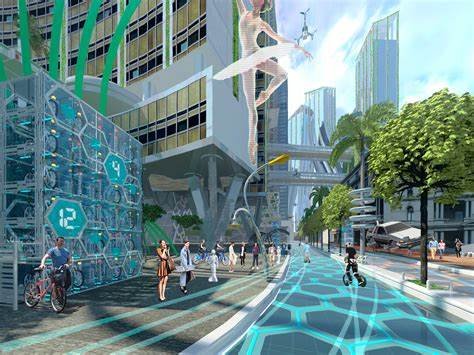In today’s world, where urbanization is on the rise and environmental challenges continue to grow, green infrastructure is becoming a key strategy for creating sustainable cities. Landscape architecture plays a crucial role in supporting and implementing green infrastructure, which includes natural systems and processes that manage environmental issues while enhancing the quality of life. In this article, we will explore how landscape architecture supports green infrastructure and its importance in creating healthier, more sustainable urban spaces.

What is Green Infrastructure?
Before we dive into how landscape architecture supports green infrastructure, it’s important to understand what green infrastructure is. Green infrastructure refers to a network of natural and semi-natural features, such as parks, wetlands, trees, and green roofs, that work together to provide environmental benefits. These spaces help manage water, improve air quality, and support biodiversity, while also enhancing the aesthetic value of urban areas.
Unlike traditional infrastructure, such as concrete drains and pipes, green infrastructure uses natural processes to solve urban problems, making it a more sustainable and environmentally friendly approach. Landscape architects are key players in planning, designing, and maintaining these green systems.
Managing Stormwater
One of the most significant ways landscape architecture supports green infrastructure is through effective stormwater management. In urban areas, large amounts of impervious surfaces like roads and buildings prevent water from soaking into the ground. This leads to surface runoff, which can cause flooding, water pollution, and erosion. Landscape architects use green infrastructure techniques to manage stormwater in a more natural way.
Rain gardens, bioswales, and permeable pavements are all examples of green infrastructure that help absorb and filter stormwater. Landscape architects design these systems to capture rainwater and allow it to slowly infiltrate into the ground, reducing runoff and improving water quality. These solutions are not only functional but also enhance the beauty and livability of urban spaces.
Reducing Urban Heat Island Effect
Urban heat island (UHI) effect occurs when cities become significantly warmer than surrounding rural areas due to human activity and the concentration of heat-absorbing materials like asphalt and concrete. Landscape architecture helps combat UHI by integrating green spaces and vegetation into urban environments.
By planting more trees, designing green roofs, and creating urban parks, landscape architects can lower the temperature in cities. Trees provide shade and cool the air through a process called evapotranspiration, where moisture from plants is released into the air, helping to cool the environment. This reduces the urban heat island effect, making cities more comfortable for residents and reducing energy consumption.
Enhancing Biodiversity
Landscape architecture also plays a key role in enhancing biodiversity through green infrastructure. As cities expand, natural habitats are often destroyed, leading to a loss of wildlife and plant species. Green infrastructure helps restore habitats and create new spaces for plants, animals, and insects to thrive.
Landscape architects design green corridors, urban forests, and wildlife-friendly parks that provide habitats for various species. By incorporating native plants, which are adapted to the local climate, landscape architects can support the local ecosystem and encourage biodiversity. These green spaces serve as refuges for wildlife and offer people a chance to connect with nature in urban environments.
Improving Air and Water Quality
Green infrastructure helps improve both air and water quality, which is vital for urban health. Plants and trees absorb carbon dioxide and other pollutants from the air, improving air quality and reducing the effects of pollution in cities. Additionally, green spaces help filter and clean water by trapping pollutants before they can enter rivers, lakes, and oceans.
Landscape architects design green infrastructure with both water and air quality in mind. For example, trees and shrubs can act as natural air filters, while wetlands and riparian buffers help to purify water. By creating systems that address both air and water quality, landscape architecture supports the overall health of urban ecosystems and their residents.
Creating Resilient Cities
Another important role of landscape architecture in supporting green infrastructure is enhancing the resilience of cities to climate change. Climate change brings about more frequent and intense storms, rising temperatures, and other environmental stresses that can impact cities and their inhabitants. Green infrastructure helps cities adapt to these changes and become more resilient.
For example, landscape architects design flood-resistant parks and floodplains that absorb excess water during heavy rains. They also create shaded areas and cooling zones in cities to reduce heat during extreme weather events. By incorporating these green features, landscape architects help build cities that can withstand the challenges posed by climate change.
Promoting Social and Economic Benefits
Green infrastructure also provides social and economic benefits, which landscape architects consider when designing urban spaces. Green spaces improve the quality of life by offering recreational areas, promoting physical activity, and providing social spaces for communities to gather. Parks, gardens, and green streets also increase property values and attract tourists, benefiting local economies.
Moreover, green infrastructure reduces the costs associated with traditional infrastructure, such as stormwater management systems and energy usage. By reducing the need for costly drainage systems and cooling infrastructure, green infrastructure provides a more cost-effective, long-term solution for managing urban environmental challenges.
Conclusion
In conclusion, landscape architecture plays a vital role in supporting green infrastructure and its many benefits. From managing stormwater to reducing the urban heat island effect, improving air and water quality, and promoting biodiversity, landscape architects create sustainable solutions that address the environmental challenges faced by cities today. By integrating green infrastructure into urban planning and design, landscape architects help create cities that are healthier, more resilient, and more connected to nature.
As urban areas continue to grow, the importance of green infrastructure will only increase. Landscape architecture provides the tools and strategies needed to build greener, more sustainable cities for future generations.




